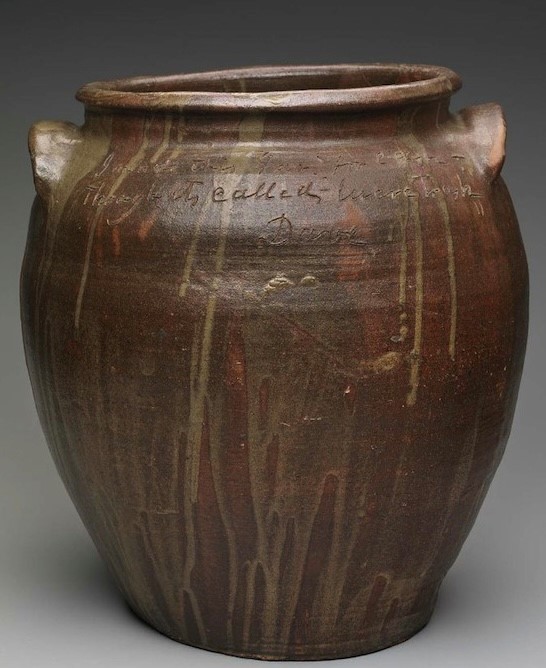Prolific David Drake, also known as Dave the Potter, was an enslaved artist born on a plantation in North Carolina in 1801. He toiled the soil and labored on several plantations and, over the course of his lifetime, was sold or traded by a number of plantation owners. Many of his family members were also separated from him through this inhumane process. By 1858, Drake now in his 50s, ended up in the Edgefield District of South Carolina on the Savannah River north of Augusta and at that time he had become the property of Harvey Drake, the publisher of the local newspaper the Edgefield Hive. By this point Drake was recognized for his pottery creations by Dr. Abner Landrum, a plantation owner who also owned Landrums’ potteries.
Between 1834 and 1866, David Drake, who had lost a foot from a train accident, had created at least 40,000 functional alkaline ceramic glaze pots, some of which could hold as many as 30 gallons. Despite legal prohibitions against enslaved people learning to read and write, Drake was literate enough to identify his work by engraving an X and then circling it with a horseshoe-shaped symbol spelling out the word “Dave.” He also dated each pot and sometimes used the initials “LM” to represent one of his earlier plantation owners, Lewis Miles. Drake also added Christian proverbs which were later recognized as a form of resistance to slavery. Drake wrote short poems as well. It is speculated that he learned to read and write from working as a typesetter at the Edgefield Hive.
One of Drake’s pots, a white kaolin clay and water “catenation” jar dated 1836, two years after South Carolina passed a punitive anti-literacy law, gives a terse account of slavery indicating that he was now communicating anti-slavery messages through his art. By 1841, however, Drake ceased writing on his pots for fear of being harmed by slaveowners or their supporters. In 2020, the catenation jar was auctioned and bought for $369,000 by the Fine Arts Museum of San Francisco.
Despite being freed by the 13th Amendment in 1865, Dave the Potter remained loyal to his former owner, Harvey Drake and embraced the former owner’s surname. Dave the Potter, now known as David Drake, died in 1874 in the Edgefield District at the approximate age of 73. In 2016, 142 years after his death, David Drake was inducted into the South Carolina Hall of Fame. Despite his prolific artistic production in slavery and in the last decade of his life as a free person, Drake and his descendants, received no proceeds from his art work that now commands millions of dollars from leading museums.
Do you find this information helpful? A small donation would help us keep this available to all. Forego a bottle of soda and donate its cost to us for the information you just learned, and feel good about helping to make it available to everyone.
BlackPast.org is a 501(c)(3) non-profit and our EIN is 26-1625373. Your donation is fully tax-deductible.
Dave Kindy, “Their enslaved ancestor’s pottery sells for over $1 million. They get nothing,” https://www.washingtonpost.com/history/2023/04/02/dave-potter-enslaved-descendants/; Jori Finkel, “The Enslaved Artist Whose Pottery Was an Act of Resistance: Poetic jars by David Drake are setting records at auction and starring in art museums, showcasing the artistry of enslaved African Americans,” https://www.nytimes.com/2021/06/17/arts/design/-enslaved-potter-david-drake-museum.html; Sarah Dolezal, “Dave the Potter’s Mark on History: An enslaved African American in South Carolina did the unthinkable, writing his name on the walls of his vessels—and forever inscribing history,” https://daily.jstor.org/dave-the-potter-mark-on-history/; Shantay Robinson, “For the Enslaved Potter David Drake, His Literary Practice Was His Resistance,” https://www.smithsonianmag.com/smithsonian-institution/dave-the-potters-resistance-was-his-literary-practice-180981707/.

